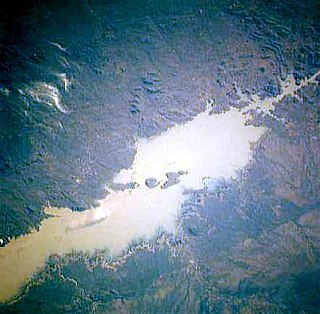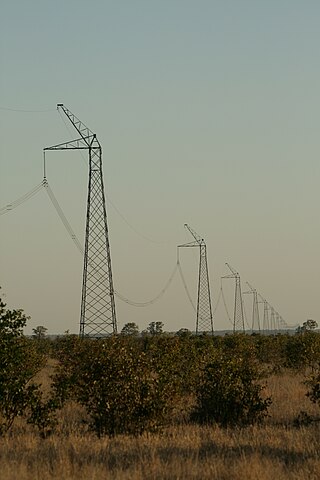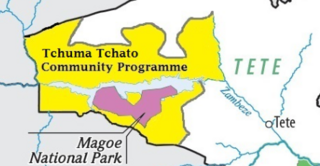
The Zambezi is the fourth-longest river in Africa, the longest east-flowing river in Africa and the largest flowing into the Indian Ocean from Africa. Its drainage basin covers 1,390,000 km2 (540,000 sq mi), slightly less than half of the Nile's. The 2,574-kilometre-long (1,599 mi) river rises in Zambia and flows through eastern Angola, along the north-eastern border of Namibia and the northern border of Botswana, then along the border between Zambia and Zimbabwe to Mozambique, where it crosses the country to empty into the Indian Ocean.

The Cahora Bassa lake—in the Portuguese colonial era known as Cabora Bassa, from Nyungwe Kahoura-Bassa, meaning "finish the job"—is Africa's fourth-largest artificial lake, situated in the Tete Province in Mozambique. In Africa, only Lake Volta in Ghana, Lake Kariba, on the Zambezi upstream of Cahora Bassa, and Egypt's Lake Nasser are bigger in terms of surface water.

Cahora-Bassa is an HVDC power transmission system between the Cahora Bassa Hydroelectric Generation Station at the Cahora Bassa Dam in Mozambique, and Johannesburg, South Africa.
Zumbo is the westernmost town in Mozambique, on the Zambezi River. Lying on the north-east bank of the Zambezi-Luangwa River confluence, it is a border town, with Zambia across the Luangwa River and Zimbabwe diagonally across the Zambezi and 2 km upstream. In 2005, Zumbo had a population of 33,000, and it lies in the Zumbo District of Tete Province.
Articles related to Mozambique include:

Cahora-Bassa District is a district of Tete Province in western Mozambique. Its administrative center is the town of Chitima. The district is located in the southwest of the province, and borders Marávia District in the north, Chiuta District in the northeast, Changara District in the east, Zimbabwe in the south, and Magoé District in the west. The area of the district is 8,712 square kilometres (3,364 sq mi). It has a population of 89,956 as of 2007.

Magoé District is a district of Tete Province in western Mozambique. Its administrative center is the town of Mpheende. The district is located in the north of the province, and borders with Zumbo District in the north, Marávia District in the northeast, Cahora-Bassa District in the east, and with Zimbabwe in the south and in the west. The area of the district is 8,792 square kilometres (3,395 sq mi). It had a population of 89,273 as of 2017.

Marávia District is a district of Tete Province in western Mozambique. Its administrative center is the town of Fingoé. The district is located in the northwest of the province, and borders with Zambia in the north, Chifunde District in the east, Chiuta District in the southeast, Cahora-Bassa District in the south, Magoé District in the southwest, and with Zumbo District in the west. The area of the district is 17,108 square kilometres (6,605 sq mi). It has a population of 82,789 as of 2007.
Ancuabe is a town in eastern Mozambique in Ancuabe District, Cabo Delgado Province. It is the seat of the district. According to the 1997 census it has a population of 12,561.

The Cahora Bassa Dam is located in Mozambique. It is one of two major dams on the Zambezi river, the other being the Kariba. The dam was finished in December 1974 after much political debate. This dam is used to convert the Zambezi River power into electricity by turning turbines. That energy is then sent to South Africa. The Cahora Bassa dam forms Cahora Bassa Lake. The dam is jointly owned by Mozambique and Portugal. From independence until 2007, eighteen percent of the dam and lake was owned by Mozambique and eighty-two percent by Portugal. Portugal sold down its share to 15 percent in 2007. The Cahora Bassa dam is the largest hydroelectric power plant in southern Africa and the most efficient power generating station in Mozambique.

Malawi–Mozambique relations refers to the current and historical relationship between the countries of Malawi and Mozambique. As Malawi shares a large border with Mozambique, much of the substance of their foreign relations pertain to the border separating the two nations. Both of the sovereign states have amicably agreed that lacustrine borders on Lake Malawi remain the largest priority between the two countries, as the exploitation of natural resources within the waters of Lake Malawi remain an issue the two countries continue to resolve. The moment considered an act of generosity and sympathy within the two countries relations is when, during the Mozambique Civil War, Malawi housed over one million Mozambican refugees between 1985 and 1995. After this gesture, Malawian relations with Mozambique crumbled under the tenure of Bingu wa Mutharika, notoriously reaching a nadir when Malawian police launched a raid into Mozambique's territory.

Magoe National Park is a protected area in Tete Province, Mozambique. The park was proclaimed in October 2013. Previously the area was an integral part of the Tchuma Tchato Community wildlife management program.

União Desportiva do Songo is a Mozambican professional football club based in Songo, Cahora-Bassa, that competes in the Moçambola.
Operation Abanadela was a military operation launched by the Portuguese Armed Forces in Mozambique during the Mozambican War of Independence against FRELIMO guerrillas in July 1970. designates a set of patrols carried out along the Zambezi River in Mozambique between 20 and 30 July 1970 in order to protect the construction of the Cahora Bassa dam from possible attacks the guerrillas of FRELIMO and the passage of these to the south towards Tete. The Portuguese patrols were carried out by small groups of soldiers from the Portuguese Marine Corps.
Operation Penada was the name of a Portuguese military operation that occurred during the Portuguese Colonial War in Mozambique, in April 1972. The Portuguese 31st Battalion of Hunters took part in the operation, the battalion had been stationed in Furancungo.
Mozambique has abundant energy sources available for exploitation. As of 2021, the country was ranked first in energy potential of all the countries in the Southern African Power Pool (SAPP), with an estimated energy capacity of 187,000 MW. Available energy sources include coal, hydroelectricity, natural gas, solar energy and wind power. As of September 2021, the largest proportion of the power currently generated is from hydroelectric sources. However the energy mix in the country is changing. Natural gas powered energy stations are expected to provide 44 percent of total energy generation from 2020 to 2030.
Allen Isaacman is an American historian specializing in the social history of Southern Africa. He is a Regents Professor of History at the University of Minnesota. In 2015, he was inducted into the American Academy of Arts and Sciences.
Biramahire Abeddy is a Rwandan</nowiki> professional footballer who plays for UD Songo club based in Songo, Cahora-Bassa, that competes in the Moçambola in Mozambique.










